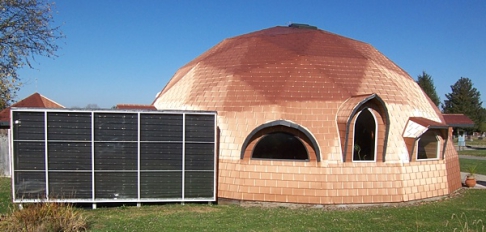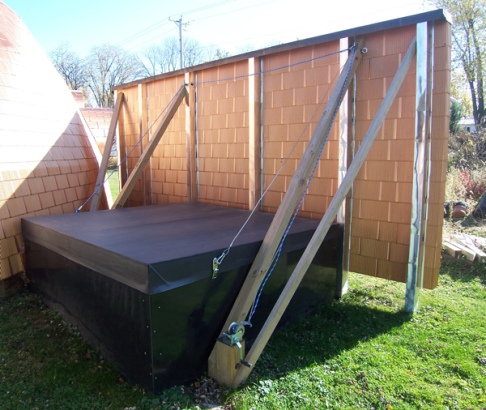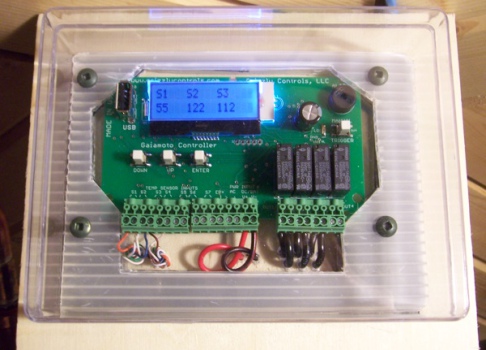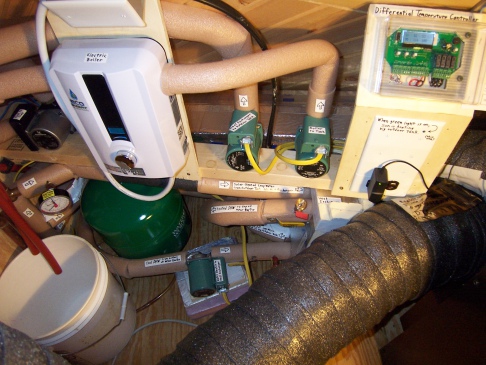Solar Heat Collector

When it's cold out, solar-heated water runs through tubing in the slab, warming the dome from below. The rest of the year the solar collector heats our domestic hot water. Both functions have electric back-up for cloudy periods.
With photovoltaic (PV) panels getting much more affordable lately, a large solar thermal project may seem an odd choice. Here's why I chose to harvest BTUs rather than electrons:
- With no natural gas to the house, a large percentage of our electricity usage goes for heat—space heat in winter, and the electric water heater year-round. Neither requires temperatures higher than what full sun can provide directly. Turning sunlight into electricity, then electricity into heat, is a convoluted and less efficient approach when the desired end product is heat.
- I could build a solar thermal project myself, but would have probably had to hire a local solar company to install grid-tied PV.
- To create the same energy savings, a professional PV installation would take up more room and cost more money, even if one could take full advantage of state and federal tax rebates.
- PV panels can get covered with snow and damaged by hail, but the vertical glazing of my solar heat collector resists both.
- Solar thermal doesn't trigger the extra connection fees that some despicable utility companies are trying to charge PV owners.
PV is a booming business, but most of the action in solar thermal these days has been among do-it-yourselfers, thanks largely to the excellent Build It Solar website. Its "$2k" system is a marvel of simplicity and effectiveness, and versions of it are providing space heat and domestic hot water for solar tinkerers all over the world.
The classic $2K system assumes a vertical south wall for mounting the collector, directly above a basement with room for a large tank next to the water heater. Unfortunately, the dome had no vertical walls, no basement, and no space to spare by the water heater.
I eventually came up with a modification of the design that could work with our particular space, height, and layout limitations. It's a 144 SF freestanding vertical collector braced to resist wind loads, paired with a low, wide, heavily insulated 300 gallon outdoor tank:

This is a drainback system. When the solar collector is 15°F warmer than the water in the big outdoor tank, tank water is pumped through the collector to be warmed by the sun. When the collector drops to nearly the same temperature as the tank, the pump stops pumping and the water drains back into the tank.
Since the only real option was to put the tank outside, I insulated it to R-60 using 10" of XPS foam with an inner 2" of foil-faced polyiso, which handles high temperatures better. To hold water, the tank is lined with EPDM rubber roofing, which is also used to cover the tank's lid and the top of the collector. The tank's exterior sides are 1/4" black high density polyethylene.
There's a 300' coil of 1" PEX tubing submerged in the tank. The water in the coil transfers heat three ways:
- When the big outdoor tank is 16°F warmer than the water heater, two pumps are activated simultaneously. They circulate the water in the coil, and water from the water heater, past each other in a stainless steel heat exchanger. When the temperature differential drops to only 10°F, the pumps shut off.
- When the King EC-R thermostat in the living room drops a degree below its set temperature, it turns on a pump that circulates the warm water in the coil through two 250' loops of 1/2" PEX tubing embedded in the concrete slab. It shuts off when the room has risen to the setpoint.
- In winter, if the big tank drops below 100°F, water in the coil is pumped through a flow-activated Eco 8 electric boiler. It exits at 140°, which raises the tank temperature as it circulates through the submerged coil. The pump and boiler shut off when the tank hits 105°F.
Except for the thermostat-controlled slab loop pump, all operations are coordinated by a single GaiaMoto programmable differential temperature controller connected to temperature sensors in the solar collector, big outdoor tank, and water heater:

The back-up electric boiler and four of the five pumps live in a corner of the small utility room off the loft:

Iowa winters can be cloudy for long stretches, and iron-gray skies provide no heat. Cold sunny days, however, are warming up the tank significantly, even short days in December near the winter solstice.
November 2015 was our first month with the system in operation. After the first snowfall, I noticed that the snow on the big outdoor tank was some of the last snow in our yard to melt (despite the 300 gallons of 100°F+ water under its lid). The tank's 12" of insulation is definitely working.
January Update: It's gotten down to -4°F at night, and the dome stayed comfortable, so I'm calling the project a success. Having slightly warm floors makes the whole dome interior very pleasant.